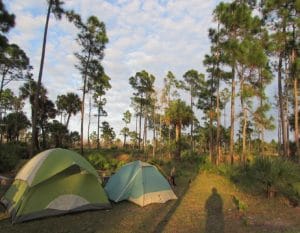Table of Contents
 Modern Definition of Primitive Campsite
Modern Definition of Primitive Campsite
At its core primitive campsites are just like they sound like: basic areas set up for camping but without any amenities you might expect at a normal campground. However, what amenities have come to be expected as standard versus what type of site is truly primitive is something that has changed – especially over the last 30 plus years.
The commonly accepted definition of a primitive campsite is one that has no modern creature comforts. This definitely includes electric hook-ups, Wi-Fi, or parking for RVs but it can also mean campsites with no toilets, latrines, or even water. Primitive campsites have many looks, but the common denominator is the feeling of “getting back to nature” due to the lack of virtually any modern amenities.
One thing that’s important to note is that “primitive campsite” will usually refer to an actual campground or common camping area that is established, while primitive camping as a practice can include a much broader array of places or areas.
Traditional Definition of Primitive Campsite
The traditional definition of primitive camping is a bit harsher or more restrictive than what the more modern common usage has been. Part of the reason for this is that the base definition of camping has changed. When my brother and I were in the Scouts in the early to mid 1990’s, camping meant you were going to break out a tent.
However, in the early to mid 2000’s I was surprised to go to multiple campsites in many states and find that I got a bunch of funny looks for throwing up a tent…because everyone else was in a camper or RV. That trend has only continued, to the point where in many even simple campgrounds you expect to have electrical outlets and water hook-ups whereas that used to be considered fairly rare and “premium.”
Because the normal definition of camping has changed (“tent camping” used to not be a term – you just assumed camping was with a tent unless otherwise told), so has the modern definition of what exactly makes a primitive campsite.
No matter which level of definition a camper is using, it is safe to assume that a primitive campsite will NEVER have access to:
- Electricity or electrical access
- Wi-Fi or Internet access
- Main Lodge or entertainment area
While to some people a tent site will in and of itself be a primitive campsite, if we’re going by the older traditional definition of what a primitive campsite is then you can also expect no:
- Latrines or plumbing facilities
- Possibly no pumps or nearby water sources
- Virtually no infrastructure of any kind
- Possibly no fire pits
When an area advertises as being a primitive campsite or emphasizes being a place for primitive campers to go, they are making it very clear what type of an experience someone can expect to have there.
How Is This Different from Primitive Camping?
Primitive campsites refer to general areas designed for camping, although sometimes the term is actually used for any camping area that a a person sets up when practicing dispersed camping. While this works in conversational use, the truth is that it isn’t quite
Primitive camping goes by many names. While the official term for it is dispersed camping, it can also be referred to as wild camping, stealth camping, or the unimaginative “off the trail” camping.
Changing Definition of Primitive Campsites
For many people today the definition of a primitive campsite is one that is built around tent camping. That means no electrical outlet, no water hook-ups. Nowadays that seems to be enough to make a campsite “primitive” in the minds of many campers. Keep this in mind if you are inviting others out for primitive camping because what they have in mind and what you have in mind could be two very different things.
With a topic like this, it’s good to make sure that everyone is on the same page!
Special Gear for Primitive Camping
Once you know what the specific lack of amenities are, make sure you have any special gear you’ll want for the weekend. If you find yourself in a campsite that doesn’t have latrines, for example, you absolutely want to make sure you have a high quality camping trowel as well as paracord to help tie together branches to make your own makeshift chair to squat on.
Obviously only do that if you’re good with knots and lashings, but one of the really great benefits of primitive camping is that you really get tested to use your skills, your imagination, and your creativity to solve otherwise common problems you’ll run into. This can be a great learning experience, and for some of us, there’s just something about customizing the experience that is great.
Oh, and unless you want to take your chance with leaves, make sure you don’t forget the biodegradable TP.
You Might Also Be Interested In…
- Wilderness Survival Rule of Three
- Can You Survive Eating Earthworms
- 50 Ways You’ll Die in the Wild
- Best Emergency Location Beacons
In Conclusion
Primitive campsites won’t be for everyone, but individuals who want to train up their wilderness survival skills in a safe environment, prep for a thru hike, or simply enjoy a campsite that isn’t going to be loaded with RVs, then this might be for you. While I admittedly like a certain level of of amenities, there are times where I just enjoy sharpening those old school outdoor skills and completely creating the camping area I’m going to enjoy.
Primitive campsites might not be for everyone, but it can be a great change of pace or a new experience for those of you looking for something different when getting back to nature. Don’t forget to pack that trowel!

